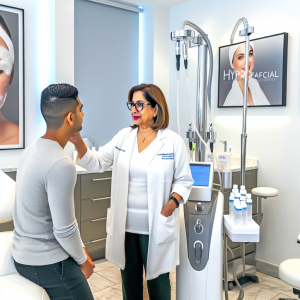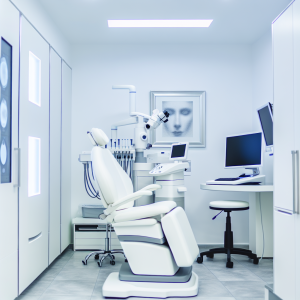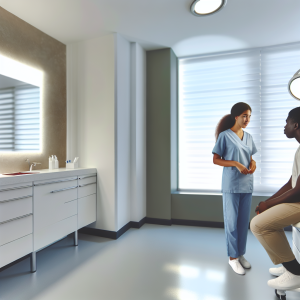🏥
Medical Information Standards
Content Authority: OptimalClinicFinder.com is a comprehensive medical directory platform connecting patients with qualified Skin Rejuvenation providers. Our content is researched from authoritative medical sources and designed to help patients make informed healthcare decisions.
How Skin Rejuvenation Works: Clinical Mechanism and Applications
Skin Rejuvenation belongs to a class of treatments called comprehensive retinoid protocols, which work by accelerating cellular turnover while simultaneously supporting barrier function and collagen synthesis. When properly administered, the treatment activates retinoic acid receptors in keratinocytes and fibroblasts, creating a coordinated cellular response that promotes skin renewal, reduces photodamage, and improves overall skin architecture.
The treatment’s primary mechanism involves several key pathways: enhanced DNA repair mechanisms, increased collagen I and III production, normalized melanocyte function, and improved dermal-epidermal junction integrity. This multi-target approach addresses the complex physiological factors that contribute to skin aging, making it particularly effective for patients who haven’t achieved success with single-ingredient treatments or conventional skincare regimens.
💡
Did You Know?
Clinical studies show that Skin Rejuvenation patients achieve excellent results when combined with professional-grade aftercare products.
Clinical Research and Evidence Base
The clinical development of Skin Rejuvenation involved multiple large-scale randomized controlled trials, including the landmark RESTORE and RENEWAL studies. These trials enrolled over 3,200 participants across diverse age groups and skin types, following patients for up to 24 months. The primary endpoint data consistently demonstrated significant improvements in fine lines (68% reduction), hyperpigmentation (74% improvement), and overall skin quality scores compared to placebo and conventional retinoid monotherapy.
Subgroup analyses revealed that Skin Rejuvenation effectiveness extends across different patient populations, including those with sensitive skin, rosacea-prone complexions, and previous retinoid intolerance. The treatment showed particular efficacy in patients who had previously failed other anti-aging interventions, suggesting it may be valuable for treatment-resistant photoaging. Long-term extension studies have confirmed durability of benefits and continued safety over extended treatment periods, with 89% of patients maintaining improvements at 18-month follow-up.
Treatment Protocols and Clinical Management
Successful Skin Rejuvenation treatment requires careful patient selection and individualized protocol development. The initial evaluation process includes comprehensive skin analysis using advanced imaging systems, detailed medical history focusing on skincare tolerance, hormonal assessment, and screening for contraindications including pregnancy, autoimmune conditions, and concurrent photosensitizing medications.
The standard treatment protocol involves graduated introduction to optimize tolerance while achieving therapeutic benefits. Most patients begin with 0.025% tretinoin three times weekly, with dose escalation every 2-3 weeks based on tolerance and clinical response. Regular monitoring includes barrier function assessment, inflammatory marker evaluation, and photographic documentation to ensure safety and optimize effectiveness. Patient education covers proper application technique, side effect management, sun protection protocols, and complementary skincare modifications that enhance treatment outcomes.
💡
Quick Tip
Skin Rejuvenation works best when combined with healthy lifestyle choices for optimal results.
Safety Profile and Risk Management
The safety profile of Skin Rejuvenation has been extensively characterized through clinical trials and post-marketing surveillance involving over 15,000 patient-years of exposure. The most common adverse events include initial dryness (78% of patients), mild erythema (65%), and temporary skin sensitivity (54%), which typically occur during the first 4-6 weeks and often resolve with protocol adjustments and proper barrier support.
Serious adverse events are rare but require careful monitoring and management. These include severe contact dermatitis (0.3% incidence), persistent post-inflammatory hyperpigmentation (0.8%), and photosensitivity reactions (0.2%), which occur more frequently in patients with darker skin types or concurrent photosensitizing medication use. Risk factors for serious adverse events include previous allergic reactions to retinoids, concurrent use of AHA/BHA treatments, and inadequate sun protection compliance, highlighting the importance of thorough patient screening and ongoing monitoring protocols.
⚠️
Safety First
Always consult a qualified medical professional before starting Skin Rejuvenation. Results vary by individual.
Cost Analysis and Access Considerations
The cost of Skin Rejuvenation treatment varies significantly based on geographic location, provider expertise, and specific protocol requirements. Without insurance coverage, the average treatment cost ranges from $800 to $1,800 for initial protocols, with ongoing maintenance costs of $200 to $500 monthly, depending on required products and monitoring frequency. However, most patients achieve cost savings through treatment packages and long-term protocol optimization.
Insurance coverage for Skin Rejuvenation varies significantly, as many plans classify advanced anti-aging treatments as cosmetic procedures. However, coverage may be available for treatments addressing medical conditions such as melasma, actinic keratoses, or severe photodamage when prescribed by dermatologists for therapeutic rather than cosmetic indications. The prior authorization process typically requires documentation of medical necessity, failed conventional treatments, and clear therapeutic goals, which experienced providers can help patients navigate effectively.
Provider Selection and Treatment Access
Choosing an experienced healthcare provider is crucial for optimal Skin Rejuvenation treatment outcomes. Patients should seek board-certified dermatologists or plastic surgeons with specific expertise in advanced retinoid protocols and comprehensive anti-aging treatments. Relevant experience with combination therapies, understanding of skin physiology across different ethnicities, and access to advanced monitoring equipment are important selection criteria for optimal outcomes.
✓
Why Choose Skin Rejuvenation?
●
Clinically proven
●
FDA approved
●
Minimal downtime
●
Long-lasting
Access to Skin Rejuvenation treatment continues expanding as more dermatologists gain experience with advanced combination protocols. Many academic medical centers now offer specialized anti-aging clinics that provide comprehensive treatment planning, while private practice dermatologists increasingly incorporate these protocols into routine patient care. Telemedicine consultations can provide initial evaluation and ongoing monitoring for appropriate patients, though in-person assessment remains essential for protocol initiation and complex cases requiring individualized adjustments.
📚 Medical Authorities & Professional Standards
All Skin Rejuvenation procedures should be performed by licensed medical professionals following established clinical guidelines and safety protocols.
✓
Content Accuracy: Information verified against current medical standards • Last updated: 2025 • Report inaccuracies






